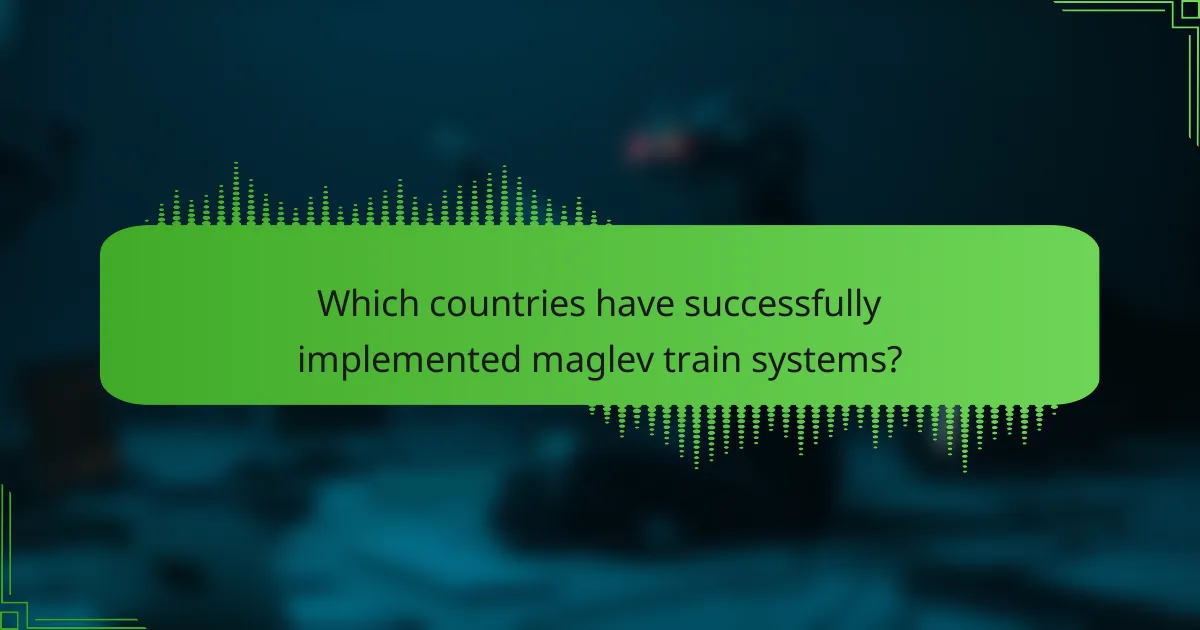Maglev trains represent a revolutionary advancement in ground transportation, achieving speeds over 300 mph with minimal friction. This article explores the operating principles of magnetic levitation, including magnetic levitation technology, linear motor propulsion, and energy efficiency. It also examines global implementations in countries like Japan, China, and Germany, highlighting their unique systems and the challenges they face in adoption. Finally, we will discuss future trends and innovations shaping the maglev landscape.

What are the fundamental operating principles of maglev trains?
Maglev trains operate on the principles of magnetic levitation, eliminating contact between the train and tracks. This technology utilizes electromagnetic forces to lift and propel the train, resulting in minimal friction and high speeds.
The fundamental operating principles include:
1. **Magnetic Levitation**: Electromagnets create a magnetic field that lifts the train above the track.
2. **Linear Motor Propulsion**: The train is propelled forward by a linear motor, converting electrical energy into motion.
3. **Guidance System**: Magnetic forces ensure precise alignment and stability on the track.
4. **Energy Efficiency**: Reduced friction leads to lower energy consumption compared to traditional trains.
These principles allow maglev trains to achieve speeds exceeding 300 mph, making them one of the fastest modes of ground transportation available globally.
How do magnetic levitation and propulsion systems work?
Magnetic levitation and propulsion systems operate using magnetic fields to lift and propel trains. These systems utilize electromagnetic forces to eliminate friction, allowing for smooth and efficient travel.
Maglev trains employ two key principles: magnetic levitation and linear propulsion. Magnetic levitation uses superconducting magnets or electromagnets to create a magnetic field that lifts the train above the track. This eliminates contact, reducing wear and energy loss.
Linear propulsion systems generate movement through synchronized magnetic fields along the track. The interaction between the train’s magnets and the track’s magnetic field propels the train forward. This method allows for high speeds and energy efficiency, making maglev trains a modern solution for transportation.
Globally, maglev technology has been implemented in various countries, including Japan and Germany, showcasing its potential for fast, reliable transit. These systems represent a significant advancement in rail technology, demonstrating the benefits of magnetic levitation and propulsion.
What technologies are used in maglev train design?
Maglev trains utilize technologies such as magnetic levitation, electromagnetic propulsion, and advanced control systems. These technologies enable trains to float above tracks, eliminating friction and allowing for high speeds. Magnetic levitation uses superconducting magnets to create lift, while electromagnetic propulsion accelerates the train. Control systems ensure safety and stability during operation.

Which countries have successfully implemented maglev train systems?
Countries that have successfully implemented maglev train systems include Japan, China, and Germany. Japan’s Shinkansen is the world’s first commercial maglev service, operational since 2021. China’s Shanghai Maglev, launched in 2004, is notable for its speed, reaching 431 km/h. Germany’s Transrapid, though not commercially used, demonstrated maglev technology in tests. These implementations showcase the potential of maglev trains in enhancing transportation efficiency and speed.
What are the notable maglev train projects in Asia?
Notable maglev train projects in Asia include the Shanghai Maglev, the Chuo Shinkansen in Japan, and South Korea’s Incheon Airport Maglev. These projects exemplify advanced magnetic levitation technology, enhancing speed and efficiency in rail transport.
The Shanghai Maglev operates at speeds up to 431 km/h, making it the fastest commercial train globally. The Chuo Shinkansen, set to connect Tokyo and Nagoya, will achieve speeds of 500 km/h upon completion. South Korea’s Incheon Airport Maglev is notable for its integration with the airport, covering a distance of 6.1 km.
These projects highlight significant investments in high-speed rail systems across Asia, showcasing the potential of maglev technology to transform transportation.
How does the United States approach maglev train development?
The United States approaches maglev train development through federal support, research initiatives, and partnerships with the private sector. The focus is on enhancing transportation efficiency and reducing travel time. Projects like the proposed Northeast Maglev aim to connect major cities quickly. Unique attributes include advanced technology and infrastructure challenges. As a result, the U.S. seeks to leverage maglev systems to modernize rail transport and improve sustainability.

What are the benefits of using maglev trains over traditional rail systems?
Maglev trains offer several advantages over traditional rail systems, including higher speeds, reduced maintenance costs, and lower energy consumption. They can reach speeds of up to 600 km/h, significantly faster than conventional trains. The absence of physical contact between the train and track minimizes wear and tear, leading to lower maintenance needs. Additionally, maglev trains operate with less friction, resulting in energy efficiency that can reduce operational costs.
How do maglev trains contribute to energy efficiency and sustainability?
Maglev trains enhance energy efficiency and sustainability through reduced friction and advanced technology. Their magnetic levitation minimizes contact with tracks, leading to lower energy consumption compared to conventional trains. For instance, maglev systems can achieve speeds exceeding 300 mph while using less energy per passenger mile. This efficiency translates into lower greenhouse gas emissions, supporting environmental goals. Additionally, maglev trains often utilize renewable energy sources, further promoting sustainability in transportation.
What impact do maglev trains have on travel times and passenger experience?
Maglev trains significantly reduce travel times and enhance passenger experience. Their magnetic levitation technology allows for higher speeds, often exceeding 300 mph, which cuts travel durations compared to conventional trains.
The smooth ride quality of maglev trains minimizes vibrations and noise, contributing to a more comfortable journey. Additionally, the spacious interiors and modern amenities create a pleasant environment for passengers.
As a result, maglev trains offer an efficient and enjoyable travel option, making them increasingly attractive for long-distance transportation.

What challenges do maglev train projects face in different regions?
Maglev train projects face numerous challenges across different regions, including high initial costs, regulatory hurdles, and varying public acceptance. Geographic factors also influence project feasibility and implementation timelines.
In regions with established rail infrastructure, integrating maglev technology can be complex. For example, existing rail lines may require significant modifications to accommodate maglev systems. Additionally, securing funding for such expensive projects often proves difficult, particularly in areas with budget constraints.
Public perception can also hinder progress. In some regions, residents may be skeptical about the benefits of maglev trains, fearing disruptions during construction or questioning their environmental impact. Effective communication and community engagement are essential to address these concerns and foster support.
Finally, varying government policies and regulations can complicate project approval processes. Regions with strict environmental regulations may face longer timelines for assessments and permits, delaying implementation.
How do funding and investment affect maglev train implementation?
Funding and investment significantly impact maglev train implementation by determining project feasibility and scale. Adequate financial resources enable advanced technology adoption and infrastructure development. For instance, government funding can accelerate research and pilot projects, while private investments can enhance operational efficiency. Countries like Japan and China illustrate this, as substantial investments have led to extensive maglev networks. Moreover, financial backing can influence public perception and political support, shaping long-term viability.
What are the regulatory and safety considerations for maglev systems?
Maglev systems require stringent regulatory and safety considerations to ensure operational efficiency and passenger safety. Key aspects include adherence to international safety standards, regular inspections, and compliance with environmental regulations.
Regulatory frameworks often involve collaboration between governmental bodies and industry stakeholders. Safety measures include advanced signaling systems, emergency protocols, and rigorous testing of infrastructure.
Additionally, unique attributes of maglev technology, such as its high-speed capabilities and low operational noise, necessitate tailored regulations. Rare considerations may involve local land use policies and community impact assessments.
Overall, the integration of these factors is crucial for the successful deployment and operation of maglev systems globally.

What unique features differentiate various maglev train systems?
Various maglev train systems differ primarily in their propulsion technologies, infrastructure requirements, and operational speeds. The two main types are electromagnetic suspension (EMS) and electrodynamic suspension (EDS). EMS systems, like the Transrapid in Germany, use electromagnets to lift and propel the train, while EDS systems, such as the Japanese Shinkansen, rely on superconducting magnets for levitation and stability.
Additionally, unique features include the operational environment; for example, some systems are designed for urban transit, while others serve intercity travel. The Shanghai Maglev, for instance, holds the record for the highest operational speed at 431 km/h, emphasizing its focus on long-distance travel. In contrast, the Nagoya Maglev prioritizes passenger comfort and efficiency over speed, showcasing how different systems cater to specific needs.
How do different maglev technologies influence performance?
Different maglev technologies significantly influence train performance through variations in speed, efficiency, and operational costs. Electromagnetic suspension (EMS) systems typically offer higher speeds and smoother rides, while electrodynamic suspension (EDS) systems provide greater stability and lower maintenance needs.
For example, the Shanghai Maglev operates at speeds up to 431 km/h, showcasing EMS efficiency, whereas Japan’s SCMaglev, utilizing EDS, achieves speeds of 603 km/h. These distinct technologies also impact energy consumption, with EDS systems often being more energy-efficient due to reduced friction.
In terms of global implementations, countries like China and Japan have adopted these technologies, reflecting their unique attributes. The choice of maglev technology ultimately shapes the overall performance and operational viability of maglev train systems worldwide.
What are the design variations among global maglev systems?
Maglev systems exhibit diverse design variations, influenced by regional technology and operational goals. Key variations include electromagnetic suspension, electrodynamic suspension, and different track configurations.
| Design Variation | Operating Principle | Notable Example | Speed (km/h) | Year Introduced |
|——————|———————|—————–|————–|——————|
| Electromagnetic Suspension | Uses magnetic forces to lift and propel the train | Shanghai Maglev | 431 | 2004 |
| Electrodynamic Suspension | Utilizes superconducting magnets for levitation | JR-Maglev | 603 | 2015 |
| Inductrack | Employs a passive magnetic levitation system | Prototype in the U.S. | 240 | 2006 |
| Hybrid Systems | Combines maglev and traditional rail technologies | Transrapid | 500 | 1984 |
| Low-Speed Maglev | Designed for urban transit systems | Linimo | 100 | 2001 |
| High-Speed Maglev | Focused on long-distance travel | Chuo Shinkansen | 500 | 2027 |

What are the future trends and innovations in maglev train technology?
Future trends in maglev train technology include advancements in superconducting materials, increased energy efficiency, and integration with smart city infrastructure. Innovations such as vacuum maglev systems are being explored for higher speeds and reduced air resistance. Additionally, countries like Japan and China are leading in the development of high-speed maglev networks, enhancing global connectivity. As a result, maglev trains are expected to play a crucial role in sustainable transportation solutions.
How is research and development shaping the next generation of maglev trains?
Research and development is driving innovations in maglev trains, enhancing speed, efficiency, and safety. New superconducting materials improve levitation and propulsion, enabling higher speeds and reduced energy consumption. Advanced control systems enhance operational safety and reliability. Countries like Japan and China are implementing cutting-edge designs, setting benchmarks for future systems. The integration of AI and smart technologies further optimizes performance and passenger experience.
What role do smart technologies play in the evolution of maglev systems?
Smart technologies significantly enhance maglev systems by improving efficiency, safety, and passenger experience. Advanced control systems optimize train operations, ensuring precise speed and braking. Real-time data analytics facilitate predictive maintenance, reducing downtime. Additionally, automation and smart sensors enhance safety measures, allowing for better monitoring of train conditions. These innovations contribute to the overall reliability and performance of maglev trains globally.
What best practices can be applied for successful maglev train projects?
Successful maglev train projects require careful planning and adherence to best practices. Key practices include thorough feasibility studies, stakeholder engagement, and robust technology selection.
1. Conduct comprehensive feasibility studies to assess economic, environmental, and technical viability.
2. Engage stakeholders early to ensure community support and address concerns.
3. Choose proven maglev technology to minimize risks and enhance reliability.
4. Implement rigorous project management practices to keep timelines and budgets on track.
5. Prioritize safety and regulatory compliance throughout the project lifecycle.
6. Foster collaboration among international experts to leverage best practices and innovations.


